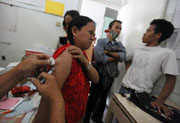VOA标准英语2011--New TB Regimen Simplifies Treatment(在线收听)
New TB Regimen Simplifies Treatment
U.S. researchers have identified a new way to treat people infected with tuberculosis before they get sick. The combination drug regimen, endorsed by the U.S. Centers for Disease Control and Prevention (CDC), would simplify treatment, cutting it from 9 months to 3 months.
The World Health Organization says tuberculosis kills nearly two million people each year. Another two billion are at risk: they are infected, but don't have symptoms of the disease.
Those at highest risk can take medicine, but Vanderbilt University researcher Timothy Stirling says not everyone follows through with the treatment, which is a daily dose of isoniazid for nine months.
"So although the medication is highly efficacious if people take all of their medication, many people do not take all their medication and therefore the effectiveness of the regimen is decreased."
As an alternative, Sterling and his colleagues combined isoniazid with another drug, rifapentine. The combination was taken weekly for just three months.
 |
| A tuberculosis patient receives free treatment at the Indonesian Union Against Tuberculosis clinic in Jakarta, April 4, 2011. |
"And the results of this study showed that the new regimen - the three months of isoniazid and rifapentine - was as effective as the nine-month isoniazid regimen," Sterling says. "And in fact, the short-course, three-month regimen had higher treatment completion rates and was also well tolerated."
There was one other difference. The two-drug, combination treatment was administered as "directly observed therapy." That means the patients took their medicine in the presence of a health care worker, to ensure that they followed the treatment protocol.
This was a large study, involving some 7,500 participants in North America, Spain, and Brazil. Sterling cautions that most of the people in this study were HIV-negative. The results might be different for HIV-positive people.
A recent study in South Africa indicated that the combination therapy works well in people infected with HIV as well as tuberculosis, but the study was too small to be definitive.
Timothy Sterling's research, in "The New England Journal of Medicine," has been endorsed by the U.S. Centers for Disease Control and Prevention, the CDC.
The government health agency recommends the 12-dose weekly combination treatment as an equal alternative to the 270-dose daily regimen that has been the standard therapy. But because of possible safety issues, the CDC still recommends the daily regimen for HIV-positive patients who are taking antiretroviral drugs or women who are pregnant.
Also, because of a lack of data, the CDC says children under age 12 should stay with the nine-month daily treatment.